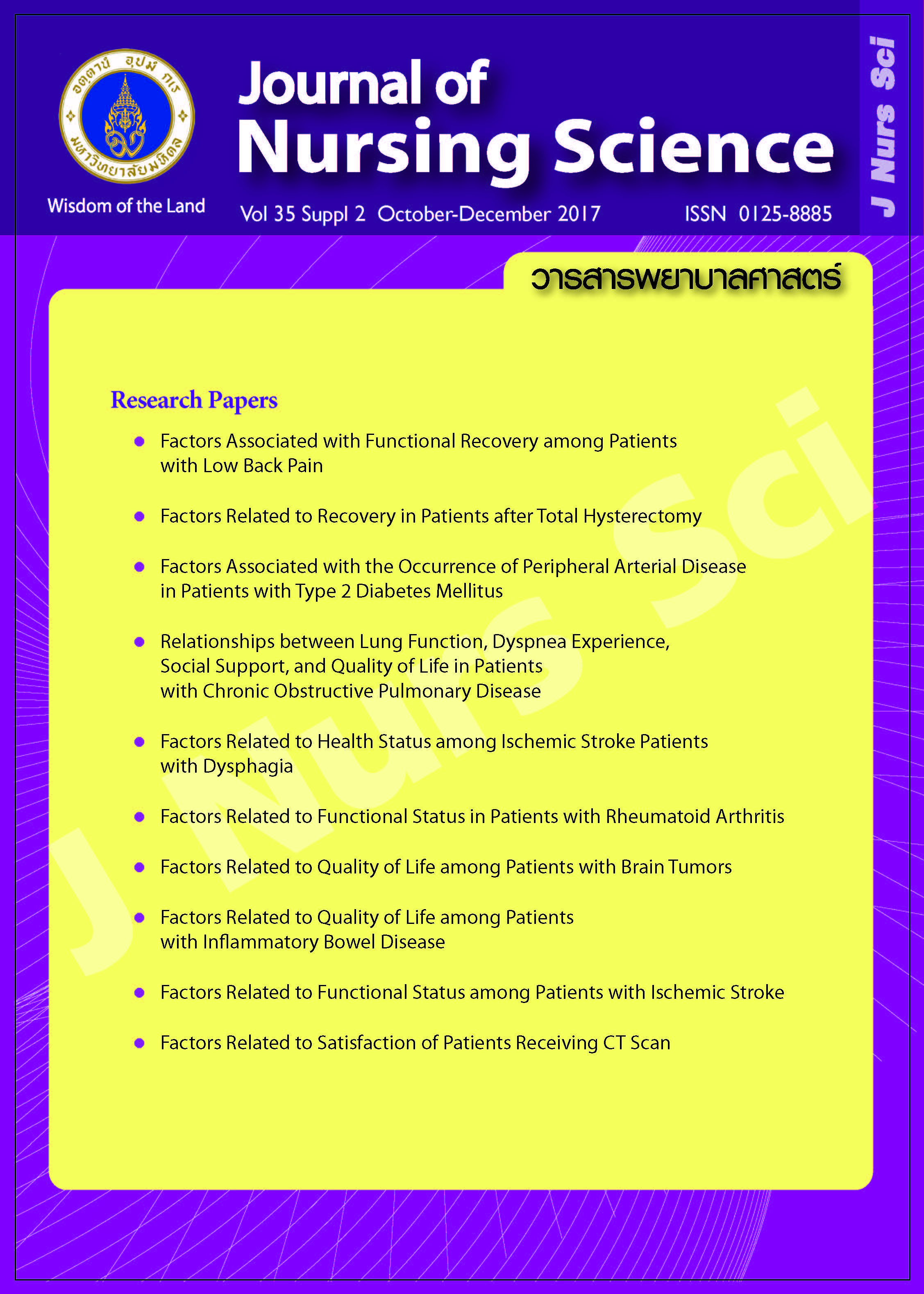Relationships between Lung Function, Dyspnea Experience, Social Support, and Quality of Life in Patients with Chronic Obstructive Pulmonary Disease* ความสัมพันธ์ระหว่างความสามารถในการทำงานของปอด ประสบการณ์การหายใจลำบาก การสนับสนุนทางสังคม และคุณภาพชีวิตในผู้ป่วยโรคปอดอุดกั้นเรื้อรัง
Main Article Content
Abstract
Purpose: To identify the relationships between lung function (FEV1), dyspnea experience, social support, and quality of life (QOL) in patients with chronic obstructive pulmonary disease (COPD).
Design: Descriptive correlational design.
Methods: The sample composed of 115 participants including males and females aged 18 years and older with COPD who were treated at Thanh Hoa General Hospital in Thanh Hoa City, Vietnam. Data were collected using the patients’ hospital records, lung function test, and 3 questionnaires: 1) the dyspnea-12 scale, 2) the Multidimensional Scale of Perceived Social Support (MSPSS), 3) the Clinical COPD Questionnaire (CCQ) to measure QOL. Descriptive statistics and Spearman’s Rho Correlation were used to analyze the data.
Main findings: The findings revealed that dyspnea experience was negatively related to QOL (rs = - .587, p < .05), lung function (FEV1) was positively related to QOL (rs = .336, p < .05), while the social support was not correlated with QOL (p > .05).
Conclusion and recommendations: The researcher recommended that nurses should promote QOL of COPD patients by developing an intervention program to prevent dyspnea and increase lung function.
บทคัดย่อ
วัตถุประสงค์: ศึกษาความสัมพันธ์ระหว่างความสามารถในการทำงานของปอด ประสบการณ์การหายใจลำบาก การสนับสนุนทางสังคม และคุณภาพชีวิตในผู้ป่วยโรคปอดอุดกั้นเรื้อรัง
รูปแบบการวิจัย: การศึกษาเชิงสหสัมพันธ์
วิธีดำเนินการวิจัย: กลุ่มตัวอย่าง จำนวน 115 คน ทั้งเพศชายและเพศหญิงอายุ 18 ปีขึ้นไป ที่เป็นโรคปอดอุดกั้นเรื้อรัง และมารับการรักษาที่โรงพยาบาล Thanh Hoa ในเมือง Thanh Hoa ประเทศเวียดนาม เก็บรวบรวมข้อมูลทั่วไปจากแฟ้มประวัติโรงพยาบาล การประเมินค่า FEV1 และแบบสอบถาม จำนวน 3 ชุด 1) แบบสอบถามการหายใจลำบาก (Dyspnea-12 scale) 2) แบบสอบถามการรับรู้การสนับสนุนทางสังคม (MSPSS) และ 3) แบบสอบถาม Clinical COPD Questionnaire (CCQ) ประเมินคุณภาพชีวิต
ผลการศึกษา: ประสบการณ์การหายใจลำบากมีความสัมพันธ์ทางลบกับคุณภาพชีวิต (rs = - .587, p < .05) ความสามารถในการทำงานของปอดมีความสัมพันธ์ทางบวกกับคุณภาพชีวิต (rs = .336, p < .05) ทั้งนี้การสนับสนุนทางสังคมไม่มีความสัมพันธ์กับคุณภาพชีวิต (p > .05)
สรุปและข้อเสนอแนะ: ผลการวิจัยพบว่า ประสบการณ์การหายใจลำบากมีความสัมพันธ์ทางลบกับคุณภาพชีวิต ขณะที่ความสามารถในการทำงานของปอดมีความสัมพันธ์ทางบวกกับคุณภาพชีวิต ดังนั้นพยาบาลควรส่งเสริม คุณภาพชีวิตของผู้ป่วยโรคปอดอุดกั้นเรื้อรัง โดยการพัฒนาโปรแกรมป้องกันภาวะหายใจลำบากและส่งเสริมความ สามารถในการทำงานของปอด
Article Details
Copyright Notice: Nursing Science Journal of Thailand has exclusive rights to publish and distribute the manuscript and all contents therein. Without the journal’s permission, the dissemination of the manuscript in another journal or online, and the reproduction of the manuscript for non-educational purpose are prohibited.

Disclaimer: The opinion expressed and figures provided in this journal, NSJT, are the sole responsibility of the authors. The editorial board bears no responsibility in this regard.
References
2. Marin JM, Cote CG, Diaz O, Lisboa C, Casanova C, Lopez MV, et al. Prognostic assessment in COPD: health related quality of life and the BODE index. Resp Med. 2011;105(6):916-21.
3. Van Minh H, Giang KB, Ngoc NB, Hai PT, Huyen DT, Khue LN, et al. Prevalence of tobacco smoking in Vietnam: findings from the global adult tobacco survey 2015. Int J Public Health. 2017;62(1):121-9.
4. Idolor LF, De Guia TS, Francisco NA, Roa CC, Ayuyao FG, Tady CZ, et al. Burden of obstructive lung disease in a rural setting in the Philippines. Respirology. 2011;16(7):1111–8.
5. Decramer M, Janssens W, Miravitlles M. Chronic obstructive pulmonary disease. Lancet. 2012;379(9823):1341-51.
6. Dinicola G, Julian L, Gregorich SE, Blanc PD, Katz PP. The role of social support in anxiety for persons with COPD. J Psychosom Res. 2013;74(2):110–5.
7. Koo MB, van Middendorp H, Lumley MA, Bijlsma JW, Greenen R. Social support and invalidation by others contribute uniquely to the understanding of physical and mental health of patients with rheumatic diseases. J Health Psychol. 2013;18(1):86-95.
8. Vestbo J, Hurd SS, Agustí AG, Jones PW, Vogelmeier C, Anzueto A, et al. Global strategy for the diagnosis, management, and prevention of chronic obstructive pulmonary disease: gold executive summary. Am J Respir Crit Care Med. 2013;187(4):347–65.
9. Polatli M, Bilgin C, Saylan B, Baslilar S, Toprak E, Hasan, E, et al. A cross sectional observational study on the influence of chronic obstructive pulmonary disease on activities of daily living: the COPD-life study. Tuberk Toraks. 2012;60(1):1-12.
10. DiBonaventura Md, Paulose-Ram R, Su J, McDonald M, Zou KH, Wagner JS, et al. The impact of COPD on quality of life, productivity loss, and resource use among the elderly United States workforce. COPD. 2012;9(1):46-57.
11. Faul F, Erdfelder E, Buchner A, Lang AG. Statistical power analyses using G*Power 3.1: tests for correlation and regression analyses. Behav Res Methods. 2009;41(4):1149-60.
12. Cohen J. A power primer. Psychol Bull. 1992;112(1):155-9.
13. van der Molen T, Willemse BW, Schokker S, ten Hacken NH, Postma DS, Juniper EF. Development, validity and responsiveness of the clinical COPD questionnaire. Health Qual Life Outcomes. 2003;1:13. PubMed PMID: 12773199; PubMed Central PMCID: PMC156640.
14. Yorke J. Editorial: Dyspnoea and pain: an interesting analogy. J Clin Nurs. 2008;17(7):841–2.
15. Canty-Mitchell J, Zimet GD. Psychometric properties of the Multidimensional Scale of Perceived Social Support in urban adolescents. Am J Community Psychol. 2000;28(3):391-400.
16. Bhanurekha B, Sasisekhar TVD, Saireddy Y, Indrakeela Girish M. Correlation of MRC dyspnoea scale and Forced Expiratory Volume in First Second (FEV1) in chronic obstructive pulmonary diseases. IOSR Journal of Dental and Medical Sciences. 2013;7(2):55-7.
17. Lin WC, Huang TY, Liu CY, Yeh ML, Yu CH, Hwang SL. Validation of the clinical COPD questionnaire in Taiwan. COPD. 2016;13(3):360-6.
18. Chhabra SK, Gupta AK, Khuma MZ. Evaluation of three scales of dyspnea in chronic obstruction pulmonary disease. Ann Thorac Med. 2009;4(3):128–32.


